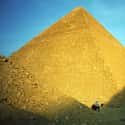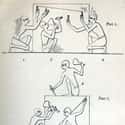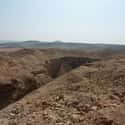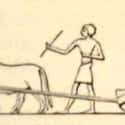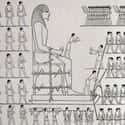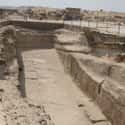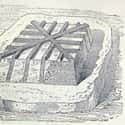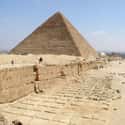-
(#1) The Ancient Egyptians Intentionally Avoided Documenting Their Methods
The Egyptians erected the Pyramids of Giza more than 4,000 years ago, but the intervening millennia are not the only reason their construction remains so mysterious. In addition to leaving most of their records in difficult-to-decipher hieroglyphs, it's also quite likely ancient Egyptians specifically chose not to document the methods behind the pyramids.
Egyptologist Kara Cooney explains why they might have kept their building techniques to themselves:
Any authoritarian regime is going to hide their secrets as long and as best as they can. The pyramids are there as mountains of stone proving the otherworldly nature of their god-kings. You stand in front of those pyramids, and you feel it's impossible to build such a thing... The propaganda is still working.
-

(#2) Workers Dug Around Granite And Pushed It Out Horizontally Rather Than Lifting It Vertically
The quarries used to mine granite for the pyramids brimmed with natural "obelisks" of rock that should have been impossible to remove from the ground with ancient technology. Instead, Egyptian workers simply removed the ground itself.
After identifying granite obelisks and chipping away at the weathered upper layers, workers dug deep trenches all around the obelisk to undercut the rock and free it from the earth. Then, they cleared a path on one side so that it could be pushed out horizontally instead of lifted out vertically - a decidedly easier task.
Much of the evidence for these techniques comes from a famed "Unfinished Obelisk" that became abandoned midway through extraction.
-
(#3) The Egyptians Used An Ingenious Technique To Cut Granite Into Blocks
Quarrying the rock-hard granite out of the earth and cutting it to shape is a difficult process even in the modern era, so archaeologists have long wondered how the ancient Egyptians managed to pull it off. The most compelling theories - backed by physical evidence - point to an ingenious method in which workers punched a series of holes in the rock with iron chisels, then stuffed those holes with wooden wedges.
The wedges were drenched with water, making them expand until they split the rock. Then, the Egyptians went to work on those fissures with their chisels until the granite got cut into a block.
-

(#4) The Egyptians' Deep Knowledge Of Physics Led To An Inventive Use Of Simple Machines
Little documentation exists to explain how ancient Egyptians built the pyramids, but evidence that has survived to the modern era - including hieroglyphs and the papyrus diary of a worker called "Merer" - hints at a culture with a deep understanding of physics.
Through their advanced knowledge of the laws of the universe, the ancient Egyptians were able to take the same "simple machines" elementary school students learn about today and apply them on a grand scale.
They didn't need advanced technology to transport tons of granite across miles of desert - instead, they merely required the use of basic technology with creativity and ingenuity.
-
(#5) Workers Used Ropes And Ramps To Lift Stones Out Of The Quarry
Once ancient Egyptians had removed obelisks of granite from the ground and cut them into blocks, they faced an even more difficult challenge: getting the blocks out of the quarry. Egyptologists have long pondered the question of how workers hefted the stones - some of which weighed dozens of tons - without the use of complex machinery, but recent discoveries indicate an inventive method with a simple design.
An ancient alabaster quarry uncovered in eastern Egypt contained a ramp-and-rope system that presumably facilitated the lifting of blocks out of the quarry. The ramp itself had two adjacent staircases with poles at regular intervals, and experts theorize that the addition of ropes to this system would have made it far easier for multiple people to pull on the blocks at once.
Though this particular quarry didn't have any connection to the construction of the pyramids, it's fair to assume they implemented similar technology in granite quarries, too.
-

(#6) Quarry Ramps Were Perhaps Used To Create A Complex Pulley System
The ramp-and-rope system uncovered in an ancient Egyptian alabaster quarry - which hints at how pyramid materials were brought up to ground level - might also provide valuable evidence for how such large stone blocks were elevated in general: pulleys.
By flanking ramps with a series of poles, workers could attach ropes to the blocks, then pull them downhill, with the poles acting as the axles in this iteration of simple machinery.
One of the few solid theories for how this ancient culture was able to lift impossibly large objects into the air entails multiple workers yanking on many simple pulleys to utilize the power of physics.
-
(#7) Rudimentary Sledges Helped Drag Material Across The Egyptian Desert
Once the granite blocks were out of the quarries, they still had to be transported across miles of desert to reach the great construction sites of Giza. Dragging tons of stone across the desert would seem a Herculean task for an ancient civilization, but the Egyptians conquered this conundrum with little more than toboggans.
Plenty of evidence has emerged of rudimentary sleds used by ancient Egyptians to haul massive materials across the sands of the Sahara. They were usually little more than flat surfaces with upturned edges, designed to glide over the dunes like a sleigh across the snow.
The substantial weight of the pyramids' granite blocks complicated the process - because heavily burdened sleds would dig into the sand - but ancient Egyptians had a solution for that, too: water.
-
(#8) Water Was Used To Wet The Sand For Easier Hauling
To transport heavy loads by sled across the sands of the Sahara, workers likely used water from the Nile to wet their path. Wet sand is much stiffer and firmer than the dry stuff - thus, it's able to carry more weight.
Researchers at the University of Amsterdam came up with and tested this theory. Their experiment was partly inspired by a wall painting in a tomb that showed the process in action. Previous Egyptologists had interpreted this water-pouring as ceremonial, but it might have had a more practical purpose.
-
(#9) Workers Constructed Oiled Tracks On Fixed Routes
Though the ancient Egyptians had the technology to drag large blocks of granite across the desert, they probably also installed fixed tracks in at least some areas. Researchers have discovered evidence of these transport routes in multiple locations. The design of the courses was brilliantly simple: round logs laid down as rails for the blocks to slide along.
These sites have also yielded traces of oiled water and animal fats, which may have helped lubricate the tracks for even greater efficiency. This rudimentary railroad likely made use of the "rope roll" systems uncovered in Egyptian quarries to conquer any upward slopes.
-

(#10) Lighter Blocks Were Floated From Canals To The Nile
An Egyptian official's papyrus diary recently uncovered by archaeologists references a series of canals connected to the Nile. These canals were used to float blocks of up to 15 tons to Giza, though heavier stones still needed to be hauled across the land.
According to the diary, wooden boats lashed together with ropes assisted in ferrying granite and limestone from Tura to Giza. The canals were functional only during the summer season when the Nile had flooded.
Their design was sophisticated enough to allow for the creation of artificial ports, including one conveniently close to the pyramid worksites.
-
(#11) Scientists Disagree About The Design Of Ramps Used To Lift Blocks
Workers implemented ramps to pull granite blocks out of ancient Egyptians quarries, and most Egyptologists agree the ramps likely helped elevate the blocks into place once they reached the construction site of the pyramids. What they don't agree on, however, is the design of said ramps.
There are numerous proposed models of these ramps, each with a set of pros and cons, ranging from simple to uncharacteristically complex. Little evidence has turned up to point researchers in any particular direction to solve this mystery.
-

(#12) Ramps Were Perhaps Used To Construct Pyramids From The Inside Out
One intriguing discovery - made possible only recently by modern technology - may represent the most concrete evidence yet of the ramp method used to construct the pyramids. A cutting-edge scanning process known as "muography" used on the Great Pyramid of Giza detected a mysterious gap that some have theorized is the remnants of a construction ramp.
Scientists have yet to probe deeper into this ambiguous void, but if it does turn out to be a construction leftover, it would lead credence to the theory that the pyramids were built with internal ramps - constructed from the inside out.
-

(#13) Wooden Rods Turn Square Blocks Into Dodecagons Anyone Can Roll Around
Joseph West of Indiana State University may have cracked the case of how ancient Egyptians moved stone blocks around once they reached the job site - and potentially up those massive ramps. As an experiment, West attached 12 rods to the sides of a block to transform it into a dodecagon that could be more easily rolled than dragged.
The experiment found that this method significantly reduced the effort needed to move such large blocks around, making it possible for a single person to push them across a considerable distance.
It wouldn't be surprising if ancient Egyptians, with their advanced knowledge of physics, figured the dodecagon method out, but there's no direct evidence to prove this theory.
-
(#14) Simple Machines Might Have Avoided The Long-Theorized Need For Dubious Sources Of Labor
Popular convention has long held that the sheer labor of hundreds of thousands of enslaved persons went into building the pyramids. This myth goes as far back as the histories of Herodotus, but modern archaeological discoveries turn the notion on its head. Evidence from the mud-brick tombs of the workers who built the pyramids suggests the builders were smaller in number and of a higher social status than previously believed.
According to researchers, the total number of builders was probably around 10,000, a significantly smaller amount than the hundreds of thousands previously reported. Combined with the archaeological evidence of several simple machines used in the extraction and transportation of granite, this new information paints a clear picture of ancient Egyptians using basic technology and ingenuity - not captives - to construct the pyramids.
New Random Displays Display All By Ranking
About This Tool
The Egyptian pyramids are the tombs of Pharaoh, the ruler of ancient Egypt more than 4,500 years ago. The ancient Egyptians believed that life is a short stay, and can only be enjoyed forever after death. Therefore, the pharaoh would spend decades building his pyramid. Facing these giant tombs of tens of meters or even hundreds of meters, archaeologists tried to obtain more information to understand why the ancient Egyptians had such superb construction skills thousands of years ago.
Pharaoh Khufu’s Pyramid is the largest. There is no cement, but it is built of stones. The average weight of the stones used to build the pyramid is 2.5 tons, and it is still difficult to insert a sharp blade into the gap between the stones. The unsolved mysteries about the Egyptian pyramids are also creepy. The random tool shows 14 details about how ancient Egyptians transported blocks to build pyramids.
Our data comes from Ranker, If you want to participate in the ranking of items displayed on this page, please click here.











